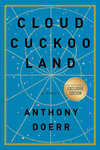

The other week I was on a call with one of my sales reps, reviewing her company’s spring publishing list, when she pitched me a book that I had initially passed on. She referred to it as being “cli-fi.”
“I’m sorry,” I said, feeling totally out of touch. Had I not spent enough time on Book Twitter lately? How had I missed this term, which sounded vaguely dirty.
“What exactly is cli-fi?”
I wasn’t sure I actually wanted to know the answer.
The answer is climate fiction, which, I suppose, is a little dirty, in a way. In this new-ish category, novels tackle how climate change can affect our world in the future, or in alternate timelines. You’ll often find them in the Science Fiction and Fantasy section of the store and they often fall under the dystopian subcategory.
These kinds of books have existed for a long time, of course (and maybe the term has, too, and I’ve just missed it). Think Margaret Atwood’s Oryx and Crake series, The Road by Cormac McCarthy, Parable of the Sower by Octavia Butler, novels written in the 1960s by J.G. Ballard.
But what has been interesting to me is how lately climate fiction has migrated from the science fiction shelf to the literary fiction shelf, how humanity’s willful destruction of the Earth has become a pervasive underlying assumption in so many novels. It has come to be a given.
I recently read three novels in a row where this struck me as true: Once There Were Wolves by Charlotte McConaughy, Cloud Cuckoo Land by Anthony Doerr, and Bewilderment by Richard Powers. In each of these books, climate change was not the point of the story or the impetus for any of the action, but there it was in the background as truth. Novels set in the real world, or near enough.
In Once There Were Wolves, the reintroduction of wolves into the Scottish Highlands is hoped to restore the forests. In the contemporary storyline of Cloud Cuckoo Land, a character befriends an owl, which is slowly driven out of the nearby forest due to a housing development. (The storyline set in the future has a group of humans on a spaceship bound for a hopefully inhabitable planet since Earth no longer suits that purpose.) And in Bewilderment, there are echoes of Greta Thunberg’s protests, among other things.
Climate change even makes itself felt in Beautiful World, Where Are You? by Sally Rooney, which I also read around the same time as the three aforementioned titles. The millennial characters feel the burden of humanity’s failures—climate change being only one of many—and despair of knowing what to do about it as individuals.
I suspect we’ll only see more nature apocalypse in our books as we go along. It’s only right that they’re moving from science fiction to realistic fiction. It’s our reality until we step up and do something about it.
Hannah Harlow is owner of The Book Shop, an independent bookstore in Beverly Farms. Harlow writes biweekly recommendations for us. See more of what she recommends reading at thecricket.com.